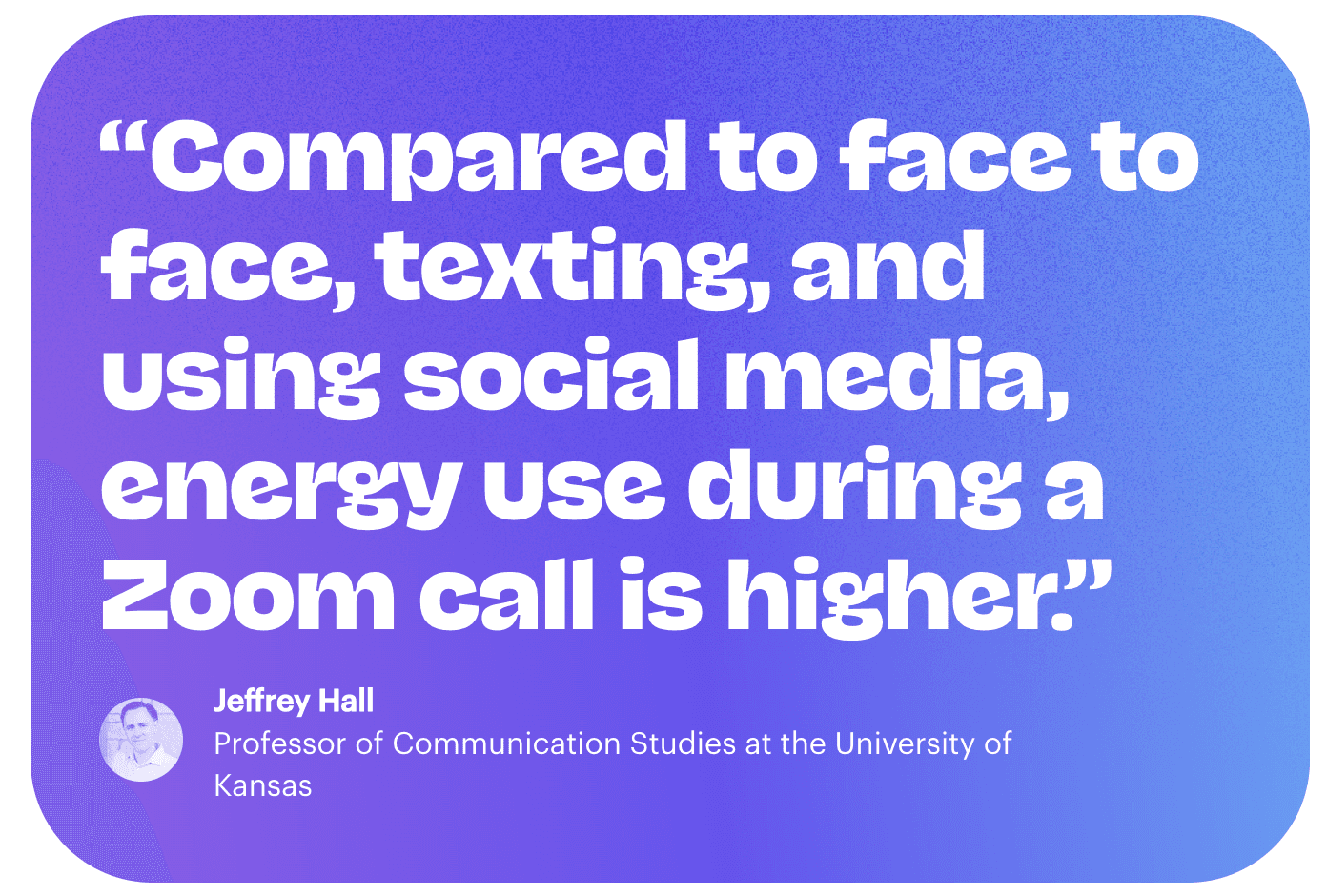July 8, 203
Synchronous Vs Asynchronous Meetings: What’s The Hype?

Dominic
There’s a lot of talk around synchronous vs asynchronous meetings at the moment, isn’t there?
It almost feels like if you’re not having asynchronous meetings then you’re being left behind. But don’t let that be your trigger for adopting asynchronous communication.
Instead, read on for the key differences between synchronous and asynchronous meetings, then decide which is right for you (and whether you agree with the hype) 👇
What is an asynchronous meeting?
An asynchronous meeting is a meeting where people don’t need to get together in real-time.
Sounds strange? The concept may be a little odd. But, in practice, it opens the door to efficiency, productivity, and freedom you never imagined.
Using asynchronous video, there’s only one person in “the meeting” at a time. A typical meeting looks like this:
The meeting “organiser” records a video with them as the only participant.
The organiser shares their screen for visual aids (spreadsheets, graphs, whiteboards, whatever you would share in a “traditional” meeting).
Everyone gets a link to watch the meeting in their own time.
People who need to respond can create their own video reply or send written feedback (email, Slack, etc.).
With some asynchronous video apps, you can add custom effects, subtitles, or combine pre-recorded videos to add more context.
Asynchronous meetings sometimes don’t need video. It’s possible to have what you know as a meeting via written communications only.
Slack details how written meetings can replace some real-time video meetings in its blog.
For example, you can set a 30-minute brainstorming session in channels. The meeting facilitator gives prompts to move the meeting along and reacts to ideas as they come flying in. There’s no talking over each other as there is no audio.
If audio or video does become a requirement, you have the option to create a video (and why not try Tella?) or start a Slack Huddle.
You’ll find asynchronous meetings do have things in common with synchronous meetings—but a ton of differences too.
What is a synchronous meeting?
A synchronous meeting is one you’re probably more familiar with. Two or more people come together in real-time to discuss something.
The synchronous element is the real-time component. Synchronous means existing or occurring at the same time.
You’re more than likely familiar with Zoom or Microsoft Teams. These are examples of synchronous meetings. But it could also be in-person in a meeting room. Remember those?!
Synchronous meetings happen all the time and are globally accepted as the norm.
But how long for?
With time becoming more and more precious, there’s long been a craving for a more efficient way to consume meeting content. And asynchronous meetings are designed to solve that very problem.
As with any type of meeting, there are pros and cons for each. We’ve included some below to help you make up your own mind.
What is the difference between synchronous and asynchronous meetings?
The table below shows the main differences between synchronous and asynchronous meetings.
Between the two lists below, spot which are most compelling for you.
1. Synchronous Meeting
Face (or voice) to face (or voice).
Reliant on bandwidth and network settings for online meetings.
Time-consuming for participants with little involvement.
May need to travel for in-person meetings.
Needs mutually agreed time.
Scheduling is time-consuming.
Recorded if the organiser remembers.
Recording may cost extra.
Restricts deep work as real-time attendance is needed.
Encourages always-on culture.
2. Asynchronous Meeting
One-to-many video or written comms.
Needs basic web access to record.
Participants can view meeting material at a time that suits.
No travel needed.
Participants can record and watch in their own time.
No scheduling needed.
Every meeting gets recorded.
Recording included in the price.
Less interruption to deep work.
Decreases pressure to respond immediately.
When the advantages of asynchronous meetings vs synchronous meetings start to become clear, it’s tempting to remove some synchronous communication from your day.
But we often find it hard to let go of Zoom.
Is Zoom synchronous or asynchronous?
Zoom is synchronous. When we all started working from home during the coronavirus pandemic, we didn’t have time to plan how we’d communicate away from the office.
Instead, we reacted by using the video conferencing software everybody else was using. And we kept using it because it was easy to use.
In no time at all, phrases like Zoom fatigue and burnout became synonymous with working from home.
This isn’t necessarily down to video technology. The concentration and stress of being online, alert, and in view can be more demanding than sitting in a meeting room.The alternative to Zoom calls all day is embracing asynchronous meetings.
Does asynchronous mean no Zoom?
When you start to have asynchronous meetings, it doesn’t mean you must have asynchronous meetings only.
If you’re fed up with sitting on Zoom all day then yes it could mean no Zoom. Some businesses work asynchronously only.
Dominic Kent, Founder of UC Marketing, says he does his best to encourage asynchronous meetings throughout his business.
“When I get a new client enquiry, they usually ask for a meeting without knowing what they need. Instead of dedicating real-time listening to them not knowing what they wish to buy, I get them to write out their deliverables or record a video using Tella. Some customers don’t get it so I explain that I work asynchronously because I’ve seen productivity increase 10x since working this way. They soon come around to the idea and love it.”
Other businesses have reduced their synchronous communication but still have the odd Zoom call so they maintain camaraderie.
For example, Rodolphe Dutel, Founder at Remotive.io, explains his typical week:
“My business partner and I have a Zoom call each Monday. Ahead of the call, we both prepare a written agenda to share with the other. During the call, we take notes. Then we go our separate ways and use asynchronous meetings and Slack the rest of the week. We don’t expect immediate answers, and get back to each other in our own time.”
So, what’s the hype with asynchronous meetings?
The hype with asynchronous meetings is already proving more than just hype. Early adopters cite two main benefits to running non-real-time catch-ups.
Asynchronous meetings reduce meeting burnout.
Asynchronous meetings enable more effective communication.
Asynchronous meetings reduce meeting burnout
Asynchronous collaboration is the new way for remote workers to have efficient meetings. Rather than having to commute two hours for a half-hour meeting, we’ve adopted virtual meetings.
But the strain on real-time communication and the always-on mentality has led to burnout and dread when it comes to joining the next meeting.
Those who have too many real-time meetings get a break from joining meetings. In addition, they also get a productive way to create content that can be consumed at a later date.
Even if you’re not suffering from video fatigue, there are plenty of benefits to asynchronous communication.
Asynchronous meetings enable more effective communication
Joey Colvin, Team Manager of Content Marketing and Strategy at mParticle, says he’s seen a clear improvement in the way his team has become more effective communicators.
“When you're in the same time zone, or in an office together, it's easy to take a question or problem and just assign a meeting to it. Before you know it, every outstanding question has its own 30 mins, 45 mins, or (god forbid) hour-long meeting and your day has disappeared.
There's nothing wrong with meetings. Some issues are better handled this way. But they can often be used as a way to avoid thinking critically about what/how you want to contribute.
When all you have is a Slack message, a comment in a Google Doc, or an email, you have to be thoughtful about how you communicate. When someone comes online and receives your message or video, they need to know exactly what you meant.
Asynchronous communication eliminates the sharing of half-baked ideas. This allows us to move much faster and have higher-quality discussions.”
It’s not just Dominic and Joey (and us). We spoke to 10 remote workers using asynchronous collaboration to be more productive than they’ve ever been.
From moving projects forward faster to only consuming relevant meeting content, remote workers can’t stop preaching the benefits of asynchronous collaboration.
Read them all here: 10 Asynchronous Meeting Examples From Remote Workers




